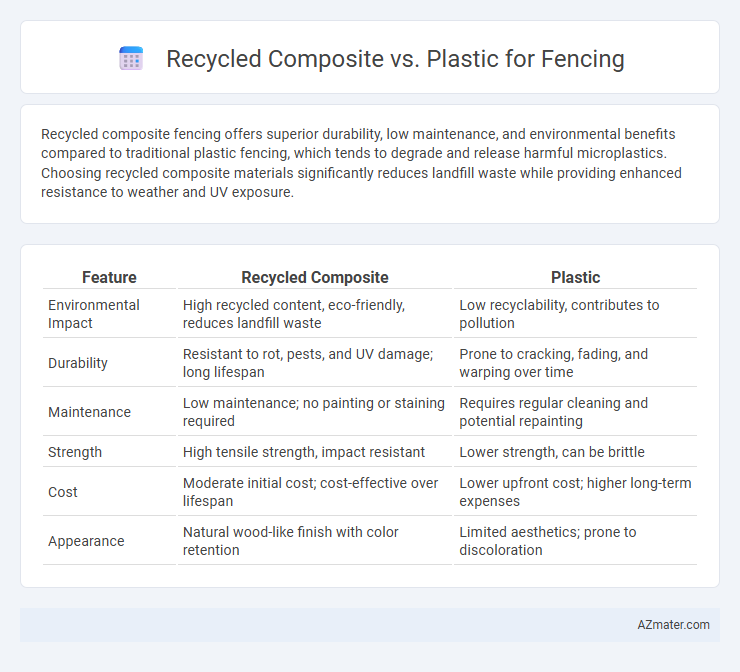Recycled composite fencing offers superior durability, low maintenance, and environmental benefits compared to traditional plastic fencing, which tends to degrade and release harmful microplastics. Choosing recycled composite materials significantly reduces landfill waste while providing enhanced resistance to weather and UV exposure.
Table of Comparison
| Feature | Recycled Composite | Plastic |
|---|---|---|
| Environmental Impact | High recycled content, eco-friendly, reduces landfill waste | Low recyclability, contributes to pollution |
| Durability | Resistant to rot, pests, and UV damage; long lifespan | Prone to cracking, fading, and warping over time |
| Maintenance | Low maintenance; no painting or staining required | Requires regular cleaning and potential repainting |
| Strength | High tensile strength, impact resistant | Lower strength, can be brittle |
| Cost | Moderate initial cost; cost-effective over lifespan | Lower upfront cost; higher long-term expenses |
| Appearance | Natural wood-like finish with color retention | Limited aesthetics; prone to discoloration |
Introduction to Fencing Material Choices
Recycled composite fencing combines wood fibers and recycled plastics, offering enhanced durability and environmental benefits over traditional plastic fencing options. Plastic fencing often uses virgin polymers, which can be less sustainable and more prone to brittleness under UV exposure. Choosing recycled composite materials supports eco-friendly building practices while providing a low-maintenance, long-lasting fencing solution.
What Are Recycled Composites?
Recycled composites are materials made by combining recycled plastics with wood fibers or other natural fillers, creating a durable and eco-friendly alternative to traditional plastic fencing. These composites offer enhanced strength, weather resistance, and low maintenance compared to standard plastic fences. Utilizing recycled composites reduces landfill waste and supports sustainable construction practices in fencing applications.
Understanding Plastic Fencing
Plastic fencing offers lightweight durability and resistance to moisture, insects, and rot, making it a low-maintenance option for various environments. Unlike recycled composite materials, plastic fencing typically lacks the structural strength and environmental benefits of repurposed content but excels in affordability and ease of installation. Choosing plastic fencing involves weighing its weather resistance and longevity against the eco-friendly advantages of recycled composites for sustainable fencing solutions.
Environmental Impact Comparison
Recycled composite fencing significantly reduces landfill waste by repurposing materials like wood fibers and plastic, lowering environmental footprint compared to conventional plastic fencing made from virgin polymers. The production of recycled composite fences consumes less energy and emits fewer greenhouse gases, enhancing sustainability in construction. Over time, recycled composite materials also exhibit improved durability and recyclability, minimizing long-term environmental degradation commonly associated with traditional plastic fencing.
Durability and Longevity
Recycled composite fencing offers superior durability and longevity compared to traditional plastic fencing due to its resistance to rot, insect damage, and UV degradation. Composite materials often blend wood fibers with recycled plastics, enhancing structural integrity and maintaining color retention over time without warping or cracking. Plastic fencing typically degrades faster under environmental stress, making recycled composite a more sustainable and long-lasting choice for outdoor fencing applications.
Maintenance Requirements
Recycled composite fencing demands significantly less maintenance compared to traditional plastic fencing, as it resists fading, warping, and insect damage without needing frequent painting or sealing. Plastic fencing often requires regular cleaning to prevent mold buildup and can become brittle under prolonged UV exposure. Choosing recycled composite reduces long-term upkeep costs while maintaining aesthetic and structural integrity over time.
Cost Analysis: Upfront and Long Term
Recycled composite fencing generally has a higher upfront cost compared to traditional plastic fencing due to the use of durable materials and advanced manufacturing processes. Over the long term, recycled composite offers cost savings through reduced maintenance, increased longevity, and resistance to weathering, decay, and pests. Plastic fencing may require more frequent replacements and repairs, leading to higher lifetime expenses despite its initial affordability.
Aesthetic Options and Customization
Recycled composite fencing offers a wide range of aesthetic options, including wood-like textures and multiple color choices, providing a natural and versatile appearance that blends well with various outdoor settings. Unlike traditional plastic fences, composite materials can be easily customized in size, shape, and finish, allowing homeowners to achieve a unique look tailored to their property's style. The durability of recycled composites ensures that these custom designs maintain their visual appeal over time without fading or warping.
Safety and Health Considerations
Recycled composite fencing offers enhanced safety compared to traditional plastic by minimizing the release of harmful chemicals such as phthalates and BPA, which are commonly associated with plastic degradation. The composite materials resist splintering and cracking, reducing injury risks to children and pets around fenced areas. Furthermore, recycled composites typically have lower thermal conductivity, preventing surface overheating and contributing to safer, healthier outdoor environments.
Conclusion: Which Fencing Material is Better?
Recycled composite fencing outperforms traditional plastic fencing in durability, environmental impact, and maintenance requirements, offering enhanced resistance to weathering and UV damage. Plastic fencing, while often cheaper upfront, tends to degrade faster and contribute more significantly to plastic waste problems. Choosing recycled composite provides a longer-lasting, eco-friendly solution that justifies its higher initial cost through sustained performance and reduced environmental footprint.

Infographic: Recycled composite vs Plastic for Fencing
 azmater.com
azmater.com